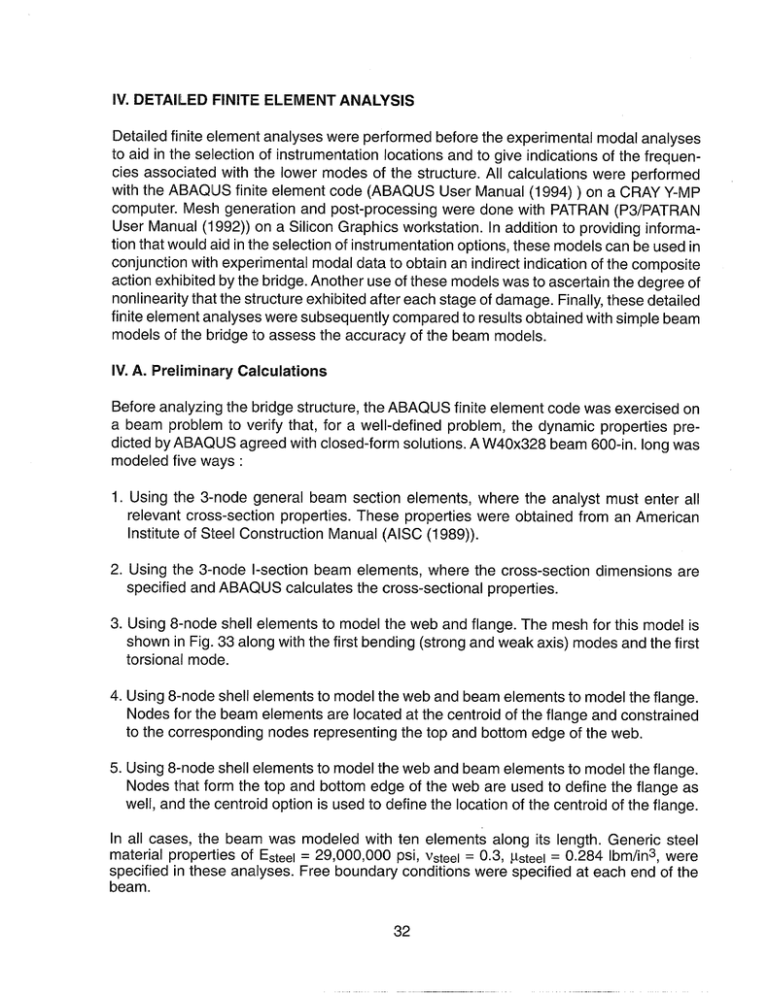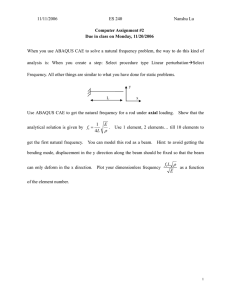IV. FINITE ELEMENT ANALYSIS Detailed finite element analyses were performed before the experimental
advertisement

IV. DETAILED FINITE ELEMENT ANALYSIS Detailed finite element analyses were performed before the experimental modal analyses to aid in the selection of instrumentation locations and to give indications of the frequencies associated with the lower modes of the structure. All calculations were performed with the ABACWS finite element code (ABAQUS User Manual (1994) ) on a CRAY Y-IMP computer. Mesh generation and post-processing were done with PATRAN (P3/PATRAN User Manual (1992)) on a Silicon Graphics workstation. In addition to providing information that would aid in the selection of instrumentation options, these models can be used in conjunction with experimental modal data to obtain an indirect indication of the composite action exhibited by the bridge. Another use of these models was to ascertain the degree of nonlinearity that the structure exhibited after each stage of damage. Finally, these detailed finite element analyses were subsequently compared to results obtained with simple beam models of the bridge to assess the accuracy of the beam models. IV. A. Preliminary Calculations Before analyzing the bridge structure, the ABAQUS finite element code was exercised on a beam problem to verify that, for a well-defined problem, the dynamic properties predicted by ABAQUS agreed with closed-form solutions. A W40X328 beam 600-in. long was modeled five ways : 1. Using the 3-node general beam section elements, where the analyst must enter all relevant cross-section properties. These properties were obtained from an American Institute of Steel Construction Manual (AISC (1 989)). 2. Using the 3-node l-section beam elements, where the cross-section specified and ABAQUS calculates the cross-sectional properties. dimensions are 3. Using 8-node shell elements to model the web and flange. The mesh for this model is shown in Fig. 33 along with the first bending (strong and weak axis) modes and the first torsional mode. 4. Using 8-node shell elements to model the web and beam elements to model the flange. Nodes for the beam elements are located at the centroid of the flange and constrained to the corresponding nodes representing the top and bottom edge of the web. 5. Using 8-node shell elements to model the web and beam elements to model the flange. Nodes that form the top and bottom edge of the web are used to define the flange as well, and the centroid option is used to define the location of the centroid of the flange. In all cases, the beam was modeled with ten elements along its length. Generic steel material properties Of Esteel = 29,000,000 psi, vsteel = 0.3, ~Steel = 0.284 lbm/in3, were specified in these analyses. Free boundary conditions were specified at each end of the beam. 32 // Fig. 33. Shell element model of the W40X328 torsional mode. beam, first bending modes, and first Results from modal analyses were compared with closed-form solutions given by Blevins (1979) to verify that ABAG?US was accurately calculating the dynamic properties of this beam. The closed-form solution for the resonant frequencies associated with free boundary conditions are f = b f_l t (k,)’ ‘i, F and (2) 27cL2 pA F JG 2L\plP’ where fb = the bending mode frequency in Hz, (Li)p =22.4 for Mode 1 (a factor to account for boundary (1979)), L = the length of the beam, E = the modulus of elasticity, 1= the cross-sectional A = cross-sectional area moment of inertia, area, ft = the torsional mode frequency in Hz, J = the torsional constant for the cross section, G = the shear modulus, v = the mass density, and 1P= Polar moment of inertia about the center of mass. 33 conditions, see Blevins It should be noted that the expression for the torsional frequency cross-sections. is only exact for circular Table Vll summarizes the results obtained. From these results it is evident that all methods of discretizing the beam give comparable results for the calculated dynamic properties of the beam. TABLE Vll Comparison of Beam Dynamic Properties Calculated by ABAQUS with ClosedForm Solutions: Free Boundary Conditions Resonant Frequency (Hz) closedform model1* model 2 model 3 model 4 model 5 MODE 1st Torsion 5.08 5.07 5.31 5.03 5.40 5.43 1st weak axis bending 1st strong axis bending 8.10 8.09 8.37 8.06 8.12 8.12 32.5 31.6 32.1 30.2 29.9 30.0 * Model refers to the elements and options used to discretize the beam as discussed in Sec. IV A. W. B. Undamaged Structure As shown in Fig. 34, the cross section of the 1-40 Bridge shown in Fig. 3 has been idealized as consisting of the following components: 1. 2. 3. 4. A concrete slab of constant thickness with a cross-sectional to that of the actual slab shown in Fig. 3. Two steel plate girders. Three steel stringers. Steel floor beams (not shown in Fig. 34) area equivalent After the beam study was complete, detailed, finite element models of the bridge were developed. The first model uses 8-node shell elements to model the web of the plate girder and the concrete deck shown in Fig. 34. Three-node beam elements were used to model thestringers, floor beam, and flanges of the plate girder. Twenty-node continuum elements were used to model the concrete piers. Horizontal and vertical stiffeners on the plate girder, the diagonal bracing, and the concrete rebar were not incorporated in this model. Generic material properties were used. The steel material properties used in the preliminary beam study (see Sec. IV. A) were also used in this model. The concrete properties used were 34







